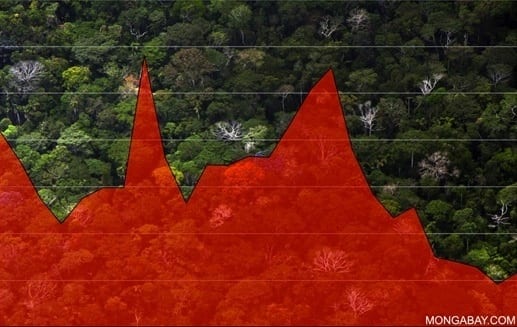

(Mongabay) Illegal logging remains pervasive in the Brazilian state of Pará, finds an assessment released Monday by Imazon.
Analyzing satellite data and records from Pará’s environmental agency Sema, the Brazil-based NGO found that 78 percent of logging documented via satellite between August 2011 and July 2012 was illegal. Some 122,337 hectares of rainforest was logged during the period, a 151 percent rise over a year earlier, when 48,802 ha were illegally harvested.
Illegal logging far outpaced legal logging in the state: the area illegally cut was three-and-a-half times larger than the 34,902 ha where sanctioned logging took place.
15 percent of illegal logging occurred in the municipality of Portel. Paragominas, the municipality that has been heralded for its progress in reducing deforestation since 2009, accounted for less than 4 percent of illegal logging.
40 percent of deforestation in the Brazilian Amazon since 2004 — 44,361 square kilometers — has occurred in Pará.
Only 2,055 ha of illegal logging occurred within indigenous reservations in the state. In contrast, more than 8,000 ha of conservation areas were illegally logged.
Almost a quarter of illegal logging took place in areas set aside for colonization under Brazil’s agrarian reform program.
The study found that legal concessions were pretty well managed, with 87 percent of operating consistently with their management plans. Less than 300 ha of the 476,454 ha under logging concessions was deforested over the past five years.
Deforestation and illegal logging in Para, Brazil. Background image courtesy of Google Earth, data from INPE and IMAZON.
The increase in illegal logging comes despite an overall drop in deforestation during the period: Pará saw its annual forest loss fall 42 percent between 2010/2011 and 2011/2012, while the Brazilian Amazon as a whole experienced a 29 percent dip. Deforestation in Brazil is down sharply since last peaking in 2004.
Still the rise of illegal logging suggests that Pará may be at risk of seeing a reversal in its downward trend in deforestation. Studies have shown that logged areas have a much higher likelihood of future deforestation relative to untouched forests. Furthermore, forests degraded by logging are more vulnerable to drought and fire, which have been worsening in the region over the past decade.
The Amazon is Earth’s largest rainforest. More than three-fifths of the Amazon lies within the borders of Brazil.
CITATION: André Monteiro, Dalton Cardoso, Denis Conrado, Adalberto Veríssimo & Carlos Souza Jr. (2013). Transparência Manejo Florestal Estado do Pará – 2011 a 2012. Imazon: Belém.
Mongabay – October 23, 2013
Read more at http://news.mongabay.com/2013/1023-illegal-logging-brazil.html#UpUD476IwX6r8aEs.99
This post was published on 8 de November de 2013
States with the most deforestation in January were Mato Grosso, Roraima and Pará Deforestation…
According to the Green Radar report, in 2024, out of the 146 companies assessed, 6…
A survey of more than 3,500 lawsuits showed an increase in punishments, while payment of…
A group made up of specialists from 23 different professions trained in the Sustainable Amazon…
The degraded area increased due to burning, especially in August and September In 2024,…
The program is scheduled to last 15 years and will include local indigenous peoples and…